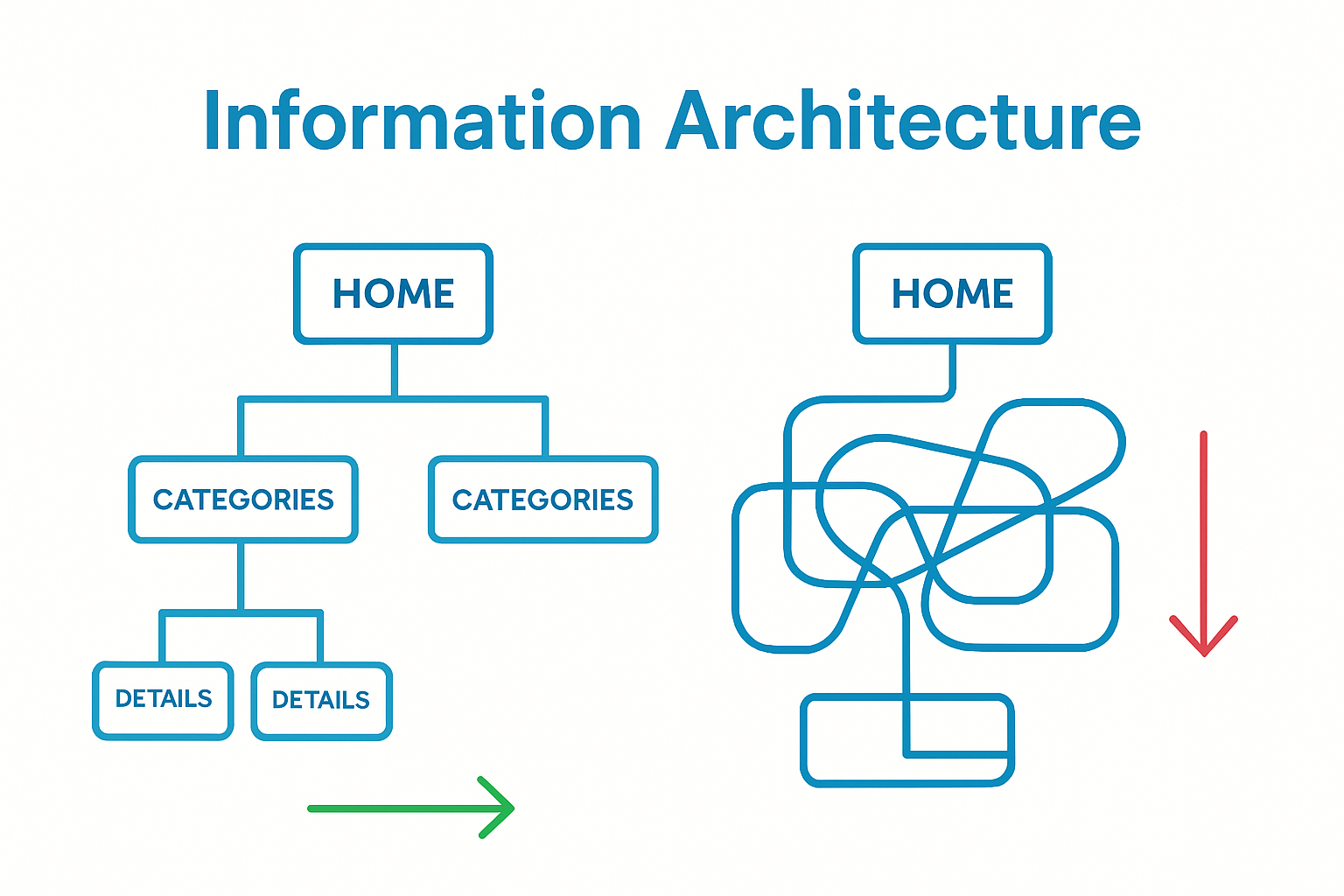Information architecture SEO shapes the way websites are built and found online. Good information architecture can lower bounce rates by up to 50 percent and dramatically improve search rankings. Most people think website organization is about picking some menu labels and a color scheme. The real breakthrough is how a site’s structure helps search engines understand meaning and intention behind every page, setting apart sites that just exist from those that truly perform.
Table of Contents
- What Is Information Architecture Seo And Why Is It Important?
- The Relationship Between Information Architecture And User Experience
- How Information Architecture Seo Influences Search Engine Rankings
- Key Concepts And Components Of Effective Information Architecture
- Practical Applications Of Information Architecture In Seo Strategies
Quick Summary
| Takeaway | Explanation |
|---|---|
| Organize website content logically | Create a clear structure for content, helping both users and search engines understand site relationships. |
| Enhance navigation pathways | Design intuitive navigation to improve user engagement and reduce bounce rates, making information easier to find. |
| Implement semantic URL structures | Use descriptive and clear URLs, aiding search engine indexing and improving user understanding of page topics. |
| Focus on user-centered design | Prioritize the needs of users during content structuring to create a seamless user experience and decrease frustration. |
| Utilize internal linking strategies | Develop meaningful internal links to enhance content discoverability and provide context for search engines. |
What is Information Architecture SEO and Why is It Important?
Information architecture (IA) in SEO represents the strategic organization and structuring of website content to enhance both user experience and search engine comprehension. At its core, IA is about creating a logical, intuitive framework that allows search engines and users to navigate and understand your digital content seamlessly.
Defining Information Architecture in the Digital Context
Information architecture goes beyond simple website design. According to Search.gov, it involves carefully planning how website content is organized, labeled, and interconnected. This approach ensures that search engines can efficiently crawl, index, and understand your website’s structure and content hierarchy.
Key elements of effective information architecture include:
- Clear and logical content categorization
- Intuitive navigation pathways
- Semantic URL structures
- Hierarchical content relationships
- User-centered design principles
The SEO Impact of Robust Information Architecture
Proper information architecture directly influences search engine rankings by providing clear signals about your content’s relevance and context. When search engines can easily understand your website’s structure, they can more accurately match your content with user search queries.
Websites with well-designed information architecture benefit from:

- Improved crawlability for search engine bots
- Enhanced user engagement and reduced bounce rates
- More accurate content indexing
- Better internal linking opportunities
To dive deeper into related optimization strategies, check out our guide on semantic HTML for SEO, which complements information architecture principles. By implementing strategic IA techniques, websites can create a more transparent, accessible digital environment that serves both users and search engines effectively.
The Relationship Between Information Architecture and User Experience
Information architecture and user experience (UX) are deeply interconnected disciplines that work together to create meaningful, intuitive digital interactions. While information architecture provides the structural blueprint, user experience ensures that this structure translates into a seamless, engaging user journey.
Understanding the Symbiotic Connection
According to Wayne State University’s research guide, effective information architecture is fundamental to enhancing user experience. The relationship goes beyond mere organization – it’s about creating an intuitive pathway that anticipates and meets user needs. Good information architecture acts as the invisible framework that guides users effortlessly through digital content.
Key aspects of this relationship include:
- Predictable navigation patterns
- Logical content hierarchies
- Reduced cognitive load for users
- Intuitive information discovery
- Seamless interaction design
How Information Architecture Supports User Experience
The strategic placement and categorization of content directly impact how users perceive and interact with a website. When information is structured thoughtfully, users can:
- Find information more quickly
- Understand website context faster
- Feel more confident navigating complex digital spaces
- Experience less frustration during information seeking
Learn more about optimizing SEO and user experience together to create digital environments that not only rank well but also provide exceptional user satisfaction. The ultimate goal is creating a harmonious digital ecosystem where structure and experience work in perfect synchronization.
This table outlines the key ways information architecture enhances both user experience and SEO performance, clarifying their benefits for site owners and audiences alike.
| Information Architecture Element | User Experience Benefit | SEO Benefit |
|---|---|---|
| Logical content categorization | Users find information quickly | Clear content hierarchy signals relevance |
| Intuitive navigation pathways | Reduced frustration, seamless interaction | Improved crawlability and indexing |
| Semantic URL structures | Users understand page topics at a glance | Better keyword relevance and content mapping |
| Meaningful internal linking | Easier discovery of related content | Passes authority, improves indexing |
| Hierarchical site structure | Confidence navigating complex pages | Strengthens topical relationships for search |
How Information Architecture SEO Influences Search Engine Rankings
Information architecture SEO serves as a critical mechanism for signaling content relevance and structure to search engines. By strategically organizing website content, businesses can significantly enhance their potential for improved search rankings and visibility.
Signals of Content Hierarchy and Relevance
According to GeeksforGeeks, a well-organized website structure helps search engines understand the complex relationships between different pages. Search engines use information architecture as a sophisticated mapping system to comprehend content context and interconnectedness.
Key ranking signals from information architecture include:
- Logical site structure and content categorization
- Clear and semantic URL hierarchies
- Meaningful internal linking strategies
- Efficient crawlability and indexing paths
- Content relationship and topical relevance
Technical Factors Impacting Search Rankings
Search engines evaluate multiple technical aspects of information architecture when determining page rankings. These technical elements go beyond simple content placement and delve into complex algorithmic assessments of website organization.
Important technical ranking considerations involve:
- Website loading speed across different page structures
- Mobile responsiveness of content organization
- Navigation complexity and user interaction patterns
- Depth of content categorization
Learn more about enhancing your SEO with structured data, which complements robust information architecture principles. By implementing strategic architectural approaches, websites can create a more transparent digital environment that simultaneously serves both users and search engine algorithms.
Key Concepts and Components of Effective Information Architecture
Information architecture represents a strategic approach to organizing digital content that balances user needs with technological requirements. By understanding its fundamental components, businesses can create more intuitive and search engine friendly digital environments.
Core Principles of Structural Design
According to the University of Arkansas, effective information architecture centers on several critical principles. These principles transform complex digital spaces into navigable, meaningful ecosystems.
Key foundational principles include:
- Focusing user choices through strategic content placement
- Progressive disclosure of information
- Using clear and representative content exemplars
- Treating every webpage as a potential entry point
- Incorporating multiple classification schemes
Essential Technical Components
Successful information architecture integrates both conceptual design and technical implementation. The structural elements work together to create a cohesive digital experience that serves both human users and search engine algorithms.
Critical technical components encompass:
- Semantic HTML structure
- Logical URL hierarchies
- Comprehensive internal linking strategies
- Clear navigation pathways
- Responsive design across devices
Explore our comprehensive guide to technical SEO foundations to complement your information architecture strategies. By meticulously crafting these architectural elements, organizations can develop digital platforms that are not just functional, but truly user-centric and search engine optimized.
The following table summarizes the core principles and technical components of effective information architecture, making it easier to compare conceptual and technical aspects side by side.
| Core Principle | Technical Component | Description |
|---|---|---|
| Focused user choices | Semantic HTML structure | Guides users by using meaningful HTML tags for content clarity and search engine understanding. |
| Progressive disclosure | Logical URL hierarchies | Reveals information in manageable sections; uses URLs that reflect content structure and relationships. |
| Representative content exemplars | Comprehensive internal linking | Uses relevant examples on pages and connects related content, supporting both users and search engines. |
| Every page as entry point | Clear navigation pathways | Designs each page to be accessible directly, with easy navigation throughout the site. |
| Multiple classification schemes | Responsive design across devices | Classifies content in different ways to match varied user needs; ensures usability on all devices. |
Practical Applications of Information Architecture in SEO Strategies
Information architecture transforms abstract organizational principles into tangible SEO strategies that drive website performance and search engine visibility. By implementing systematic approaches, businesses can create digital environments that are both user friendly and algorithmically optimized.
Strategic Content Mapping and Organization
According to Yale University’s guide, effective information architecture integrates three critical components: context, content, and users. Successful SEO strategies require a holistic approach that considers these interconnected elements.
Key strategic mapping considerations include:
- Creating comprehensive content taxonomies
- Developing intuitive site hierarchies
- Establishing clear content relationships
- Implementing semantic categorization
- Designing scalable content structures
Technical Implementation and Optimization
Practical information architecture goes beyond conceptual planning and demands precise technical execution. Search engines evaluate websites based on their structural integrity, navigability, and content organization.
Critical technical optimization strategies involve:
- Developing clean, descriptive URL structures
- Implementing strategic internal linking
Learn more about technical SEO foundations that complement information architecture principles. By meticulously aligning content structure with search engine requirements, organizations can create digital platforms that are not just discoverable, but fundamentally designed for optimal search performance.
Take Control of Your Site Structure and Eliminate SEO Overlap Today
Are you struggling to make sense of your website’s information architecture and worried that fragmented content might be holding back your search rankings? With complex site structures, overlapping topics, and hidden duplicate keywords, even the best-designed frameworks can suffer from keyword cannibalization and crawlability issues. Your goal of achieving clear hierarchies, strong internal linking, and higher rankings depends on removing these roadblocks. The pain is real when your carefully structured content falls victim to keyword confusion and diluted authority.
Imagine how much easier SEO would be with full visibility into how your pages compete for the same keywords. That is exactly what you get from the #1 Keyword Cannibalization Tool trusted by SEO consultants and agencies. Instantly scan your entire site and see where weak internal structures or cannibalization hurt your rankings. Move beyond guesswork. Get a clear map of your true information architecture and unlock your site’s potential right now by visiting RankAligner. Your next step toward stronger and more effective information architecture starts here.
Frequently Asked Questions
What is information architecture in SEO?
Information architecture in SEO refers to the strategic organization and structuring of website content to improve user experience and search engine comprehension. It ensures that both users and search engines can navigate and understand your content easily.
Why is information architecture important for SEO?
Information architecture is important for SEO because it enhances the crawlability and indexing of a website. A well-structured site allows search engines to understand content relevance, leading to better rankings and visibility.
How can I improve my website’s information architecture?
You can improve your website’s information architecture by creating clear content categories, using intuitive navigation pathways, establishing semantic URL structures, and ensuring a logical hierarchy of information.
What are the key components of effective information architecture?
Key components of effective information architecture include clear content categorization, logical site structure, semantic HTML, comprehensive internal linking strategies, and user-centered design principles.

